Introduction
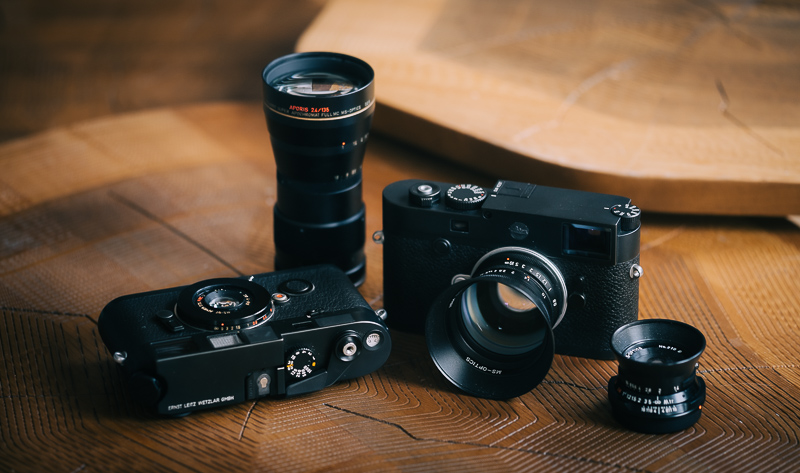
Especially in the western world it is hard to find any useful information on the MS-Optics lenses, let alone an overview. Having used quite a few of them myself I decided to put such an overview together and collect as much information as I can.
The guys from mkdirect51.com as well as japanexposures.com allowed me to use their product pictures and I also made use of some more from fotoborse.blog.jp. All of these are online shops selling MS-Optics lenses and I already personally bought at least one lens from Japan Exposures as well as MK Direct and had good buying experiences in both cases. Further information comes from the books “The World of Miyazaki Lenses” Part 1 and 2.
You can find pictures of the all the MS-Optics M-mount lenses and scans of their data sheets here. These data sheets are in Japanese, you can use e.g. the Google Translate app on your phone to decipher them, it works reasonably well. Nevertheless, I already collected the specifications from these texts and translated them for you.
I didn’t get a chance to use all of these lenses myself yet. If you are located in the EU, happen to own one of the lenses without a review, and would be willing to send it to me for a few weeks to write one, it would be greatly appreciated. Just leave a comment to get in contact!
Contents
- Introduction
- About MS-Optics
- MS-Optics M-mount Lenses
- Perar 17mm 4.5
- Hipolion 19mm 8.0
- Perar 21mm 4.5
- Aporia 24mm 2.0
- Perar 24mm 4.0
- Apoqualia 28mm 1.7
- Apoqualia 28mm 2.0
- Perar 28mm 4.0
- Apoqualia 35mm 1.3 II Slim
- Apoqualia 35mm 1.4
- Perar 35mm 3.5
- Apollon 36mm 1.3
- Historio Prot 40mm 6.3
- Historio Dagonar 40mm 6.3
- ISM 50mm 1.0
- Sonnetar 50mm 1.1
- MS-Mode 50mm 1.3
- Sonnetar 50mm 1.3 Slim
- Varioprasma 50mm 1.5
- MS-Mode 50mm 3.5 Apoqualia
- Xenomax 50mm 3.5
- Elnomaxim 55mm 1.2
- Petz 57mm 2.0
- Sonnetar 73mm 1.5
- Aporis 135mm 2.4
- Trivia
- Further reading
- Support Us
About MS-Optics
MS-Optics (formerly known as MS-Optical R&D) is a small lens manufactory from Japan established in 2006. The “MS” in MS-Optics stands for Miyazaki Sadayasu (born in 1940), CEO of the company and designer of all these lenses.

The MS-Optics lenses are quite a bit different from other modern lenses. Usually they feature a low element count, they don’t make use of aspherical elements and the optical formula is still calculated by hand. The emphasize is on small size and not on a perfect correction of optical aberrations at the maximum aperture or most efficient operation.
All the lenses discussed in this article are Leica M-mount lenses, but they can of course be adapted to other mirrorless systems.
MS-Optics M-mount Lenses
Perar 17mm 4.5
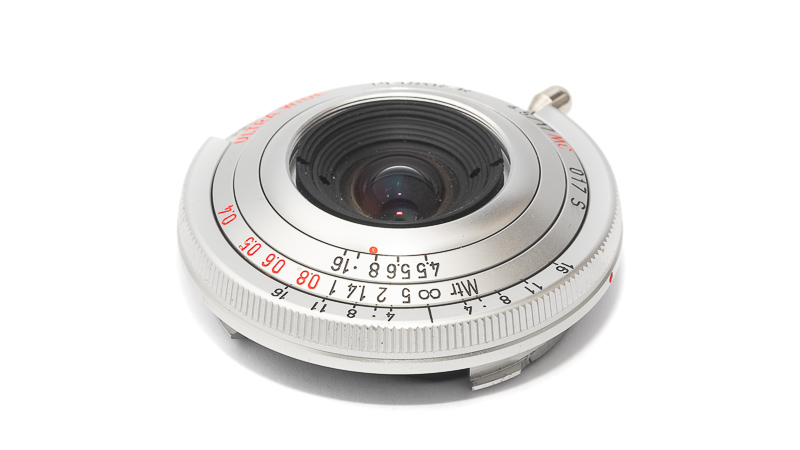
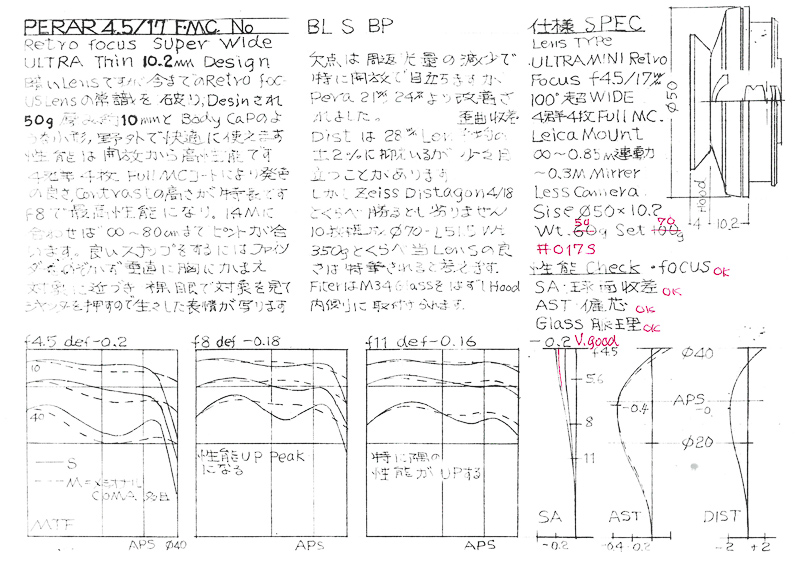
Full Review: MS-Optics Perar 17mm 4.5
-
- Diameter: 50mm
- Length: 10.2mm
- Weight: 47g (measured, without hood)
- Filter Diameter: 34mm*
- Number of Aperture Blades: 10
- Elements/Groups: 4/4
- Close Focusing Distance: 0.3m (measured)
- First released: January 2017
*you are supposed to salvage the glass from a 34mm filter and glue that glass element to the lens hood
Personal opinion:
At wider apertures the sharpness in the corner/border regions leaves a bit to be desired, for architecture the high, wavy distortion additionally gets in the way. I recommend to use this lens at f/11 to f/16 and to fix the high distortion in post (there is a Lightroom Profile available).
Hipolion 19mm 8.0


- 19.5mm f/8.0
- Diameter: 50mm
- Length: 2.6mm
- Weight: 27g
- Filter Diameter: –
- Number of Aperture Blades: 10 (straight)
- Elements/Groups: 2/2
- Close Focusing Distance: 0.3m
- First released: December 2020
Personal opinion:
An ultra wide angle lens made from only two lens elements is quite remarkable, but looking at the MTF graphs it really needs stopping down to f/11 to f/16 to deliver good results. This is also the smallest MS-Optics lens and probably the smallest M-mount lens altogether.
Perar 21mm 4.5


- 21.5mm f/4.5
- Diameter: 50mm
- Length: 5.2mm
- Weight: 45g
- Filter Diameter: 25mm*
- Number of Aperture Blades: 10
- Elements/Groups: 3/3
- Close Focusing Distance: 0.5m
- First released: May 2015
*you are supposed to salvage the glass from a 25mm filter and glue that glass element to the lens hood
Aporia 24mm 2.0

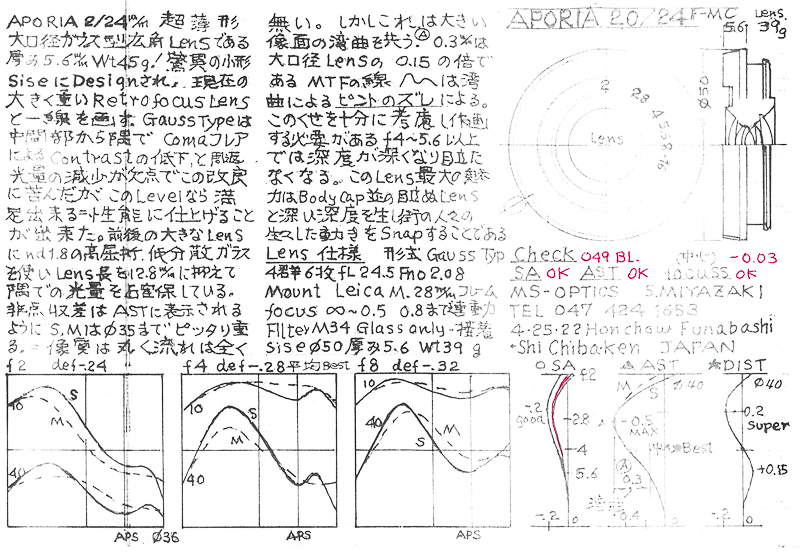
Full Review: MS-Optics Aporia 24mm 2.0
-
- 24.5mm f/2.08
- Diameter: 47mm
- Length: 5.8mm
- Weight: 45g
- Filter Diameter: 34mm*
- Number of Aperture Blades: 10 (straight)
- Elements/Groups: 6/4
- Close Focusing Distance: 0.5m
- First released: September 2020
*a normal 34mm filter will not fit, you are supposed to salvage one and put (or glue) only the glass from it in the small lens hood provided
Personal opinion:
Surprisingly fast for its size and also surprisingly capable. Stopped down to f/8.0 to f/11 its performance is hard to distinguish from normal non pancake lenses for most applications, which is remarkable.
Perar 24mm 4.0


- 24.6mm f/4.08
- Diameter: 50mm
- Length: 5.2mm
- Weight: 35g
- Filter Diameter: 19mm*
- Number of Aperture Blades: 10
- Elements/Groups: 3/3
- Close Focusing Distance: 0.65m
- First released: June 2014
*you are supposed to salvage the glass from a 19mm filter and glue that glass element to the lens hood
Apoqualia 28mm 1.7


- 28.8mm f/1.73
- Diameter: 50mm
- Length: 10.2mm
- Weight: 54g (withoud hood and caps)
- Filter Diameter: 34mm (actually 32mm according to a reader)
- Number of Aperture Blades: 12 (rounded)
- Elements/Groups: 6/4
- Close Focusing Distance: 0.4m
- First released: July 2023
The slightly faster successor to the MS-Optics 28mm 2.0 Apoqualia (next entry on this list). The mechanical design is similar to the Mark III of the 28mm 2.0 and apart from the slightly faster maximum aperture this new lens also performs very similar to the old one, meaning there is a lot of field curvature.
Apoqualia 28mm 2.0
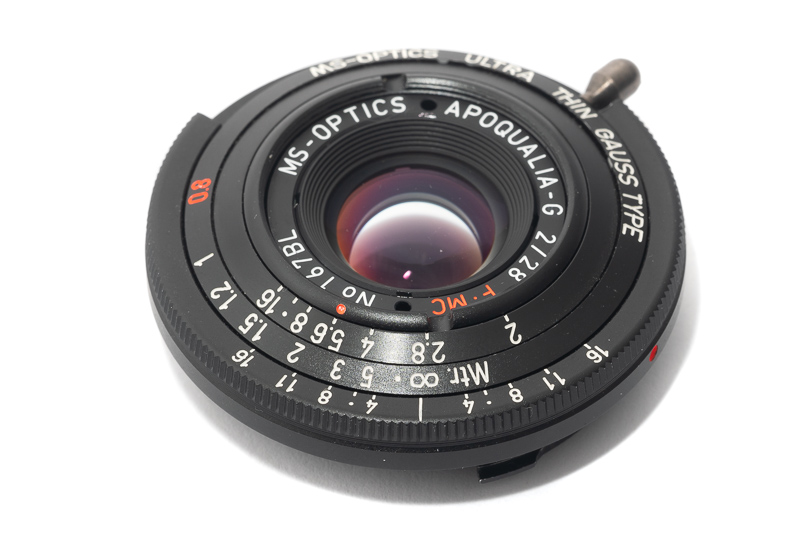
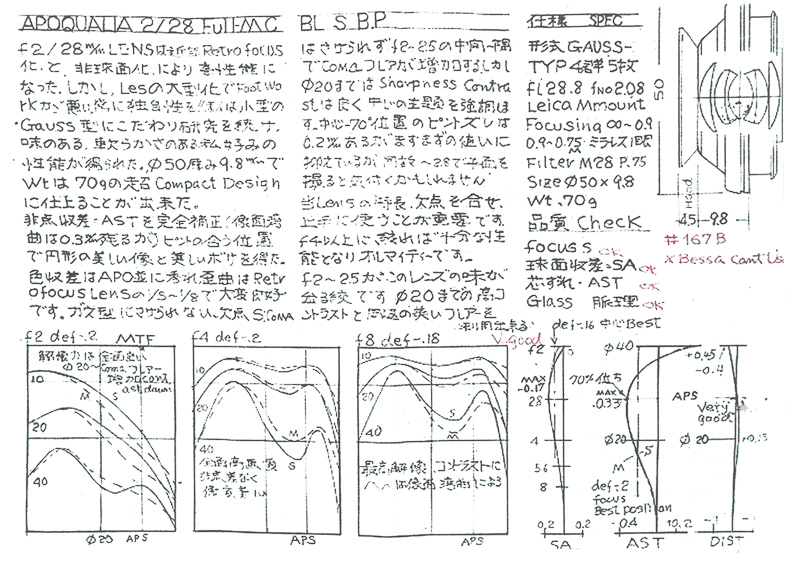
Full Review: MS-Optics 28mm 2.0 Apoqualia MKI
- 28.8mm f/2.08
- Diameter: 50mm
- Length: 9.0mm
- Weight: ~50g
- Filter Diameter: 28mm
- Number of Aperture Blades: 10 (rounded)
- Elements/Groups: 6/4
- Close Focusing Distance: 0.8m [0.35m for Mark III]
- First released: September 2016
The MS-Optics 28mm 2.0 Apoqualia has been rereleased and its mechanical design been updated several times over the years. The picture and datasheet here belong to Mark I, the latest Mark III offers a different casing design and a minimum focus distance of 0.35m. The optical design remains unchanged between all three versions.
Perar 28mm 4.0

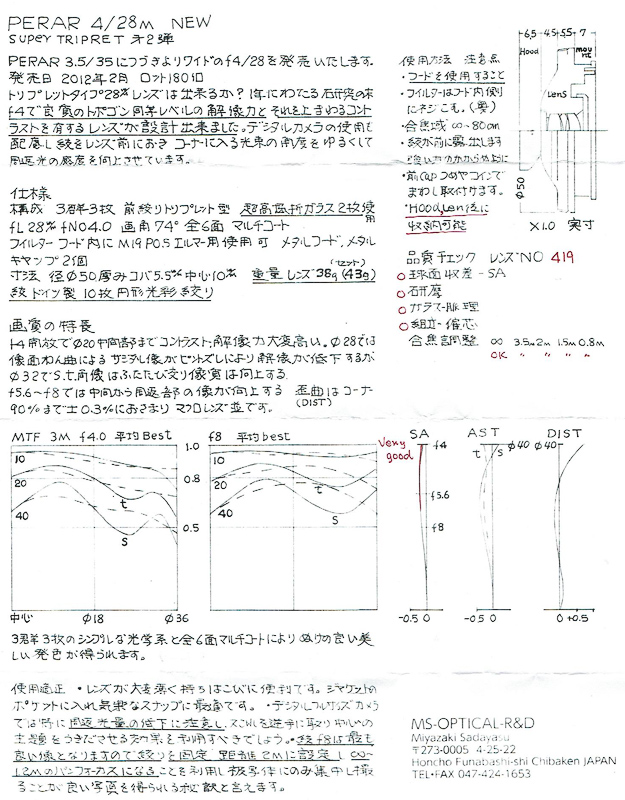
- Diameter: 50mm
- Length: 10mm
- Weight: 38g
- Filter Diameter: 19mm*
- Number of Aperture Blades: 10
- Elements/Groups: 3/3
- Close Focusing Distance: 0.8m
- First released: February 2012
*you are supposed to salvage the glass from a 19mm filter and glue that glass element to the lens hood
The aperture diaphragm is exposed on top of the front element, therefore this lens needs to be handled with extreme care.
Apoqualia 35mm 1.3 II Slim
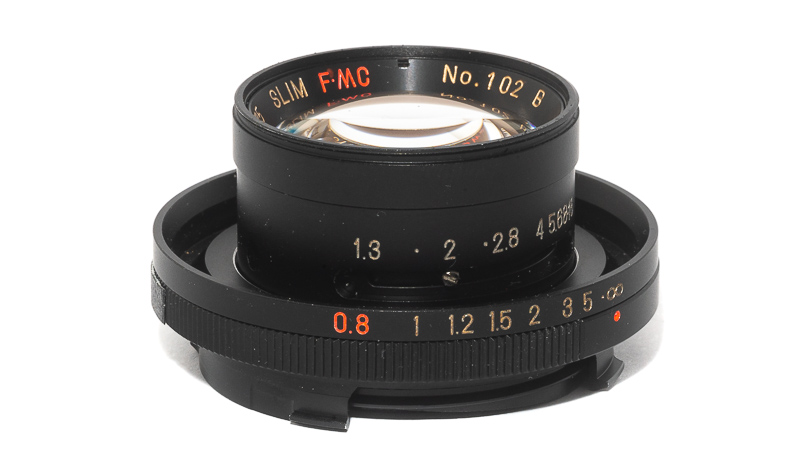
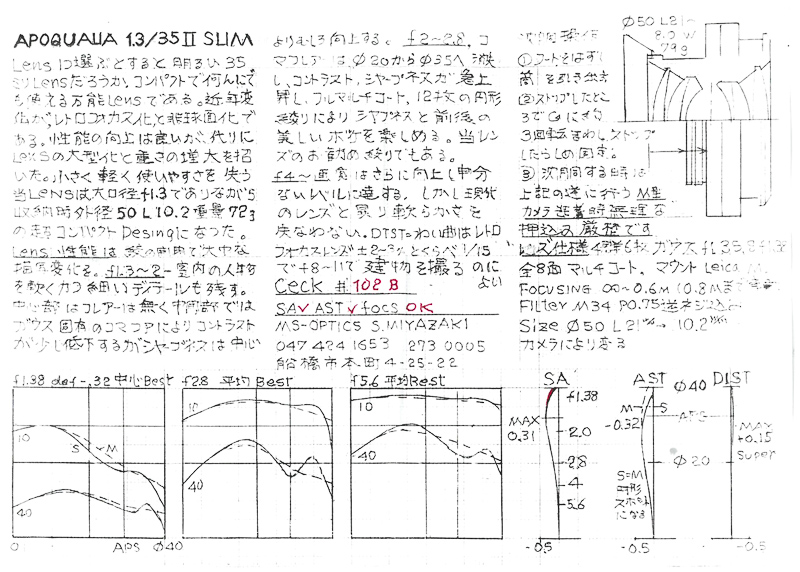
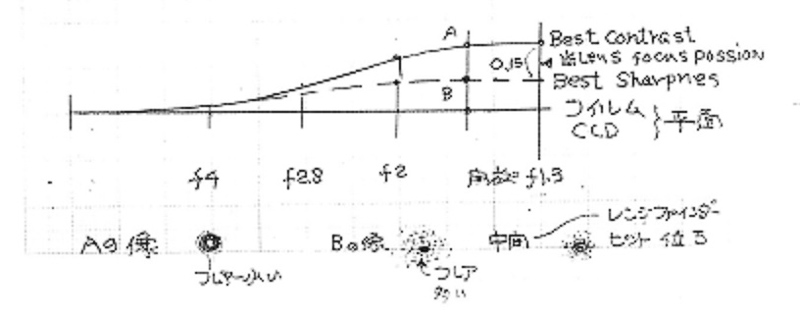
Full Review: MS-Optics Apoqualia 35mm 1.3 Slim II
- 35.8mm f/1.38
- Diameter: 50mm
- Length: 21mm (without hood)
- Weight: 61g (measured, without hood)
- Filter Diameter: 34mm (reversed)
- Number of Aperture Blades: 14 (rounded)
- Elements/Groups: 6/4
- Close Focusing Distance: 0.54m (measured)
- First released: October 2021
There are collapsible and non collapsible (“lock type”) versions available.
Personal opinion:
Because of sharpness and contrast not peaking in the same focal plane I find it hard to focus at f/1.3 to f/2.0. Stopped down border and corner regions never look really good.
Apoqualia 35mm 1.4
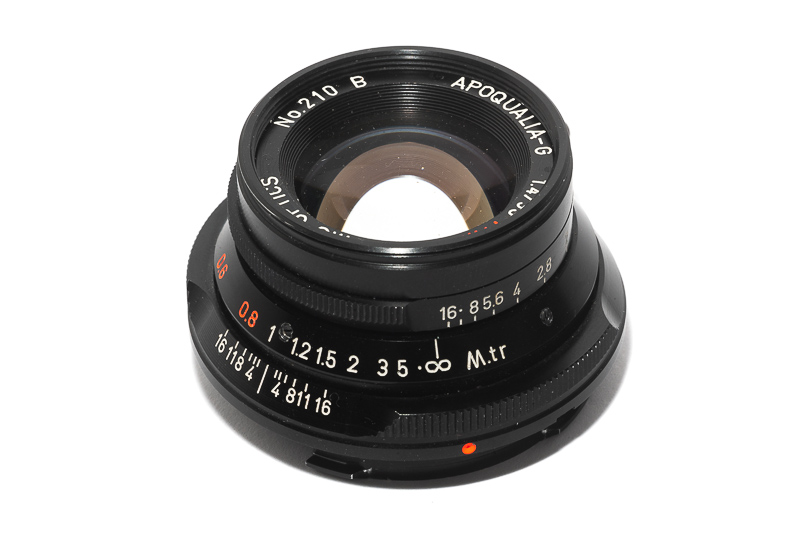
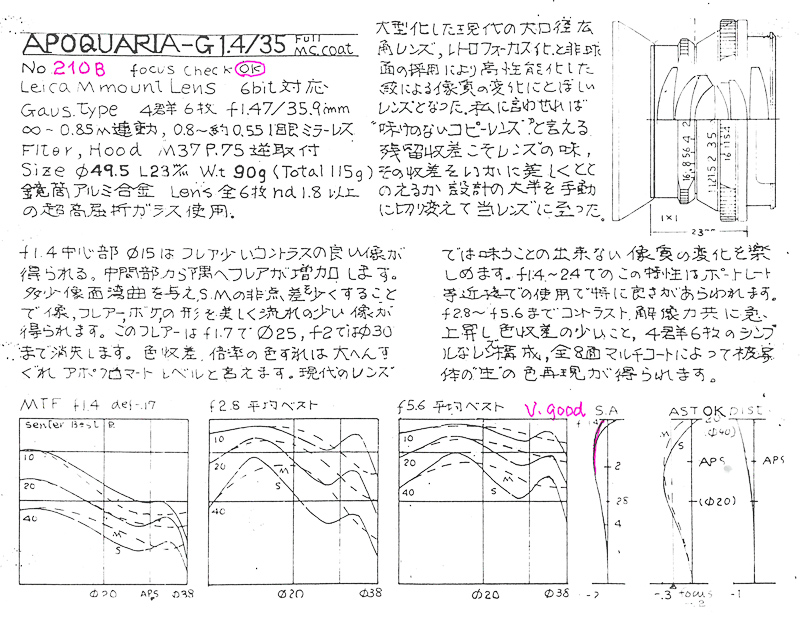
Full Review: MS-Optics Apoqualia 35mm 1.4
-
- 35.9mm f/1.47
- Diameter: 50mm (without hood)
- Length: 24mm (without hood)
- Weight: 85g (measured, without hood)
- Filter Diameter: 37mm (reversed) + 46mm (in lens hood)
- Number of Aperture Blades: 12 (rounded)
- Elements/Groups: 6/4
- Close Focusing Distance: 0.6m (measured)
- First released: November 2015
A special edition with same optics but different casing named Reiroal was sold through Map Camera only.
Personal opinion:
One of my favorite MS-Optics lenses. I see it more as a 35mm 2.0 lens as I don’t really like its rendering at f/1.4, but it is still a capable and compact fast 35mm lens that let’s you not only shoot in dimly lit situations but is also sharp into the corners stopped down.
Perar 35mm 3.5
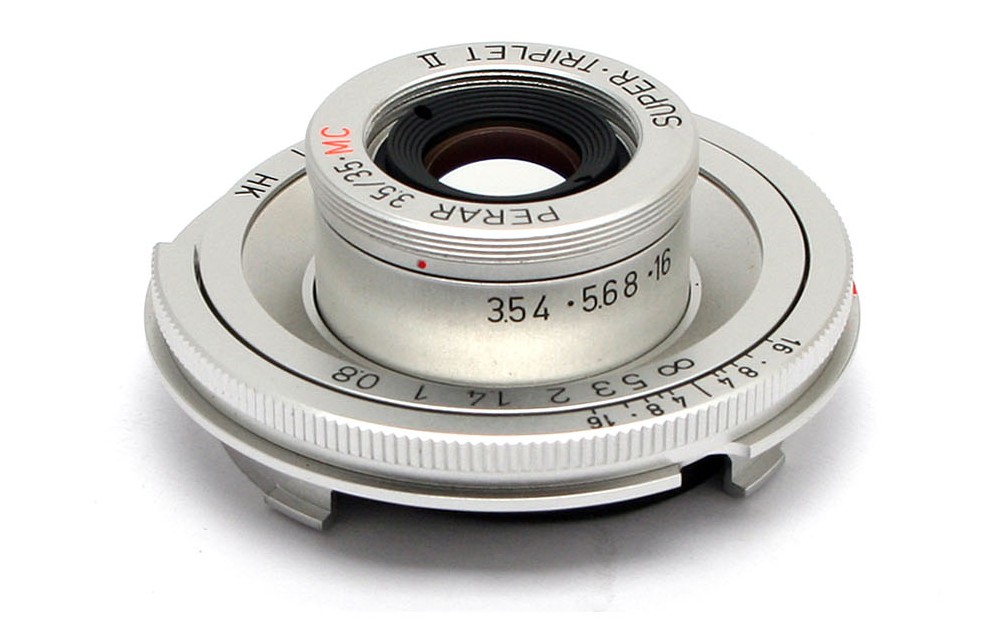

- Diameter: 50mm
- Length: 13.2mm (extended)
- Weight: 75g
- Filter Diameter: 19mm
- Number of Aperture Blades: 10
- Elements/Groups: 3/3
- Close Focusing Distance: 0.8m
- First released: August 2010
Apollon 36mm 1.3

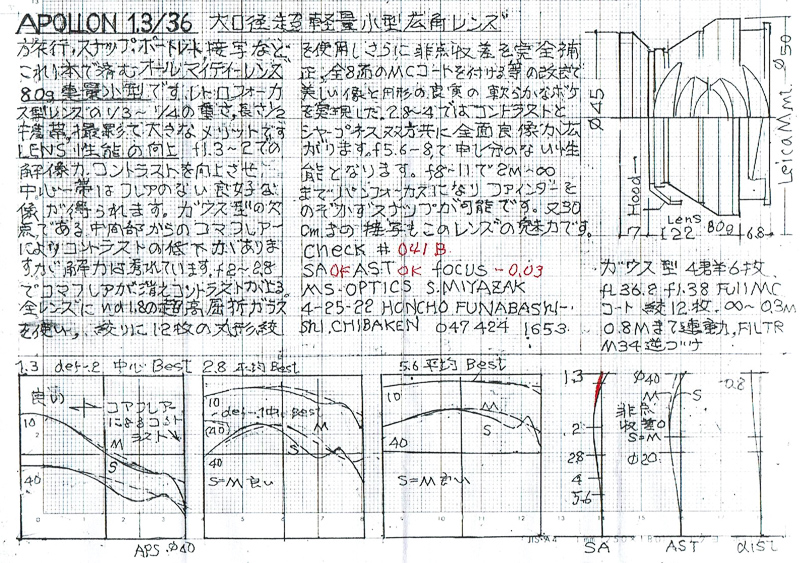
- 36.2mm f/1.38
- Diameter: 50mm
- Length: 22mm
- Weight: 80g
- Filter Diameter: 34mm (reversed)
- Number of Aperture Blades: 14 (rounded)
- Elements/Groups: 6/4
- Close Focusing Distance: 0.3m
- First released: December 2022
Historio Prot 40mm 6.3


- Diameter: 50mm
- Length: 16.2mm
- Weight: 47g
- Filter Diameter: 22.5mm
- Number of Aperture Blades: 10 (mostly straight)
- Elements/Groups: 4/2
- Close Focusing Distance: 0.6m
- First released: March 2018
Historio Dagonar 40mm 6.3


- Diameter: 50mm
- Length: 22.2mm
- Weight: 50g
- Filter Diameter: 22.5mm
- Number of Aperture Blades: 10 (mostly straight)
- Elements/Groups: 6/2
- Close Focusing Distance: 0.6m
- First released: June 2018
ISM 50mm 1.0


Full Review: MS-Optics ISM 50mm 1.0
- 51.5mm f/1.05
- Diameter: 56mm
- Length: 40mm
- Weight: 172g (measured, without hood)
- Filter Diameter: 55mm (reversed) + 67mm (in lens hood)
- Number of Aperture Blades: 16 (rounded)
- Elements/Groups: 7/5
- Close Focusing Distance: 0.7m (measured)
- First released: August 2018
Personal opinion:
Actually a lens with hard to overlook flaws and a bit restrained to shooting at wider apertures – due to the corners getting pitch black stopped down – but with a quite appealing look at f/1.4.
Personally I like it way more than the popular 50mm 1.1 Sonnetar.
Sonnetar 50mm 1.1
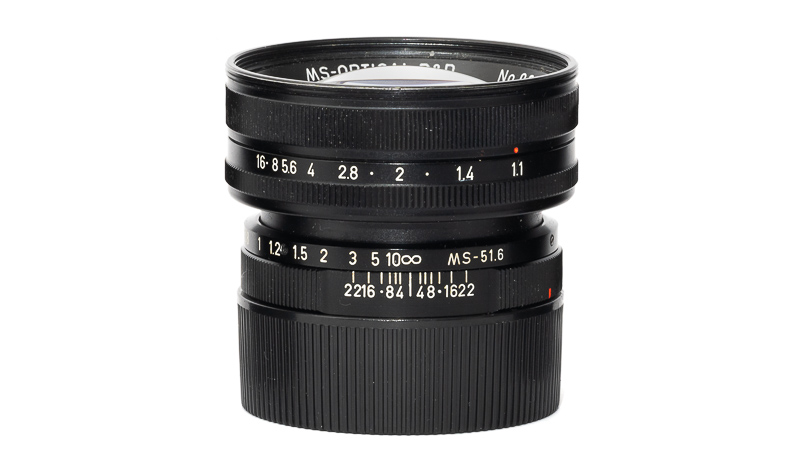

Full Review: MS-Optics Sonnetar 50mm 1.1
- 51.7mm f/1.16
- Diameter: 56mm
- Length: 36mm
- Weight: 195g (measured, without hood)
- Filter Diameter: 52mm + 55mm (reversed) + 62mm (in lens hood)
- Number of Aperture Blades: 14 (rounded)
- Elements/Groups: 5/4
- Close Focusing Distance: 0.68m (measured)
- First released: June 2013
Personal opinion:
This is probably the most popular MS-Optics lens, but not my personal favorite, as it shows high and unfavourable field curvature which messes up the bokeh at longer focus distances.
MS-Mode 50mm 1.3


- 52.04mm f/1.377
- Diameter: 51.2mm
- Length: 35.7mm
- Weight: 165g
- Filter Diameter: 49mm
- Number of Aperture Blades: 12 (rounded)
- Elements/Groups: 5/4
- Close Focusing Distance: 1.0m
- First released: October 2006
This is the first MS-Optics lens. Was also available for Nikon S rangefinder cameras.
Sonnetar 50mm 1.3 Slim
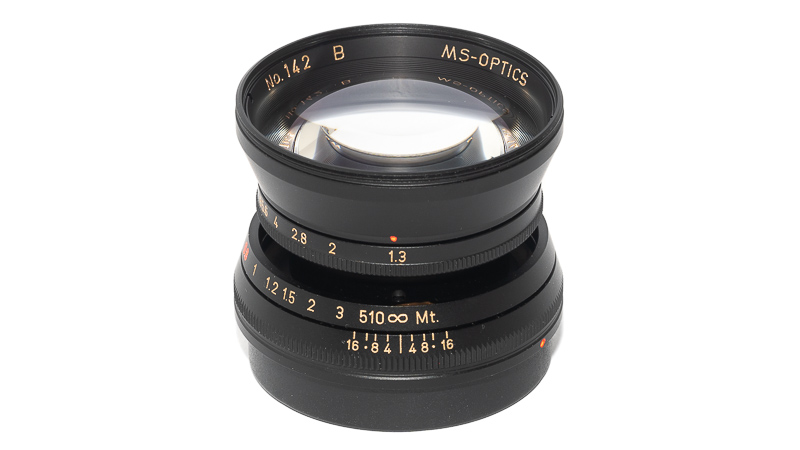
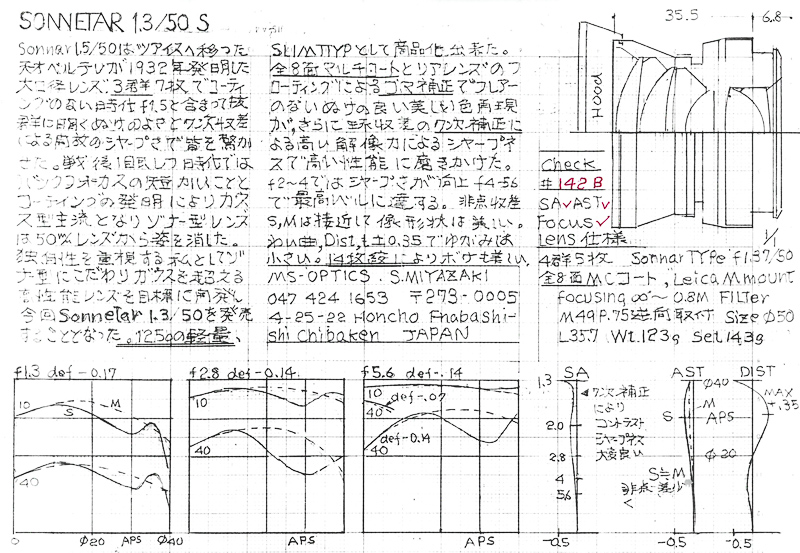
Full Review: MS-Optics 50mm 1.3 Sonnetar Slim
- 50mm f/1.37
- Diameter: 50mm
- Length: 35.5mm
- Weight: 127g (measured, without hood)
- Filter Diameter: 49mm (reversed) + 55mm (in lens hood)
- Number of Aperture Blades: 14 (rounded)
- Elements/Groups: 5/4
- Close Focusing Distance: 0.6m (measured)
- First released: February 2022
Personal opinion:
Compared to the 50mm 1.1 Sonnetar and 50mm 1.0 ISM this lens feels like a somewhat more polished product, without giving up on typical MS-Optics characteristics.
Varioprasma 50mm 1.5
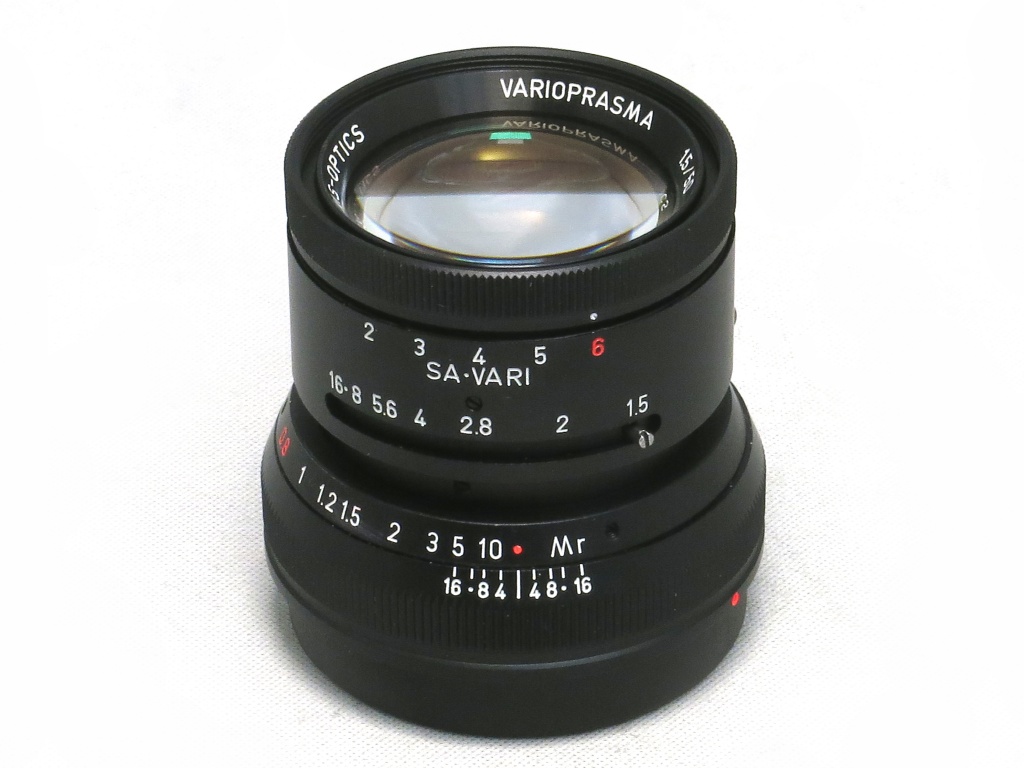

- 52mm f/1.58
- Diameter: 50mm
- Length: 43mm
- Weight: 135g
- Filter Diameter: 39mm
- Number of Aperture Blades: 16
- Elements/Groups: 6/4
- Close Focusing Distance: 0.8m
- First released: August 2019
MS-Mode 50mm 3.5 Apoqualia


- 51.9mm f/3.58
- Diameter: 50mm
- Length: 38.5mm (extended)
- Weight: 90g
- Filter Diameter: 30.5mm
- Number of Aperture Blades: 12
- Elements/Groups: 5/3
- Close Focusing Distance: 0.85m
- First released: December 2009
The second MS-Optics lens and one with a very low production count as only 170 units have been produced.
Xenomax 50mm 3.5
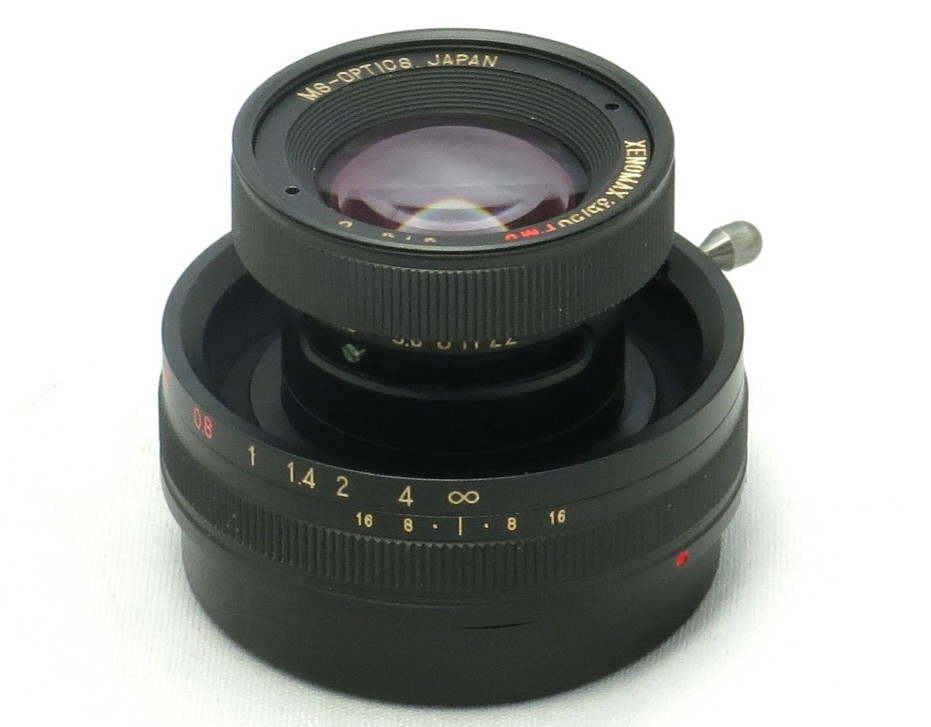

- 51.6mm f/3.5
- Diameter: 50mm
- Length: 33mm
- Weight: 65g
- Filter Diameter: 37mm (reversed)
- Number of Aperture Blades: 12
- Elements/Groups: 5/4
- Close Focusing Distance: 0.5m
- First released: June 2022
Personal opinion:
The successor to the aforementioned early MS-Mode 50mm 3.5 lens. Despite the small size and low weight the optical performance looks very good – not only according to the MTF graph but also to pictures I have seen from an owner. Also covers 44×33 mm sensors.
Elnomaxim 55mm 1.2


- 55.6mm f/1.26
- Diameter: 50mm
- Length: 43mm
- Weight: 180g
- Filter Diameter: 49mm (reversed)
- Number of Aperture Blades: 16 (rounded)
- Elements/Groups: 4/4
- Close Focusing Distance: 0.8m
- First released: September 2020
Personal opinion:
Based on what I have seen in a few sample pictures online this lens shows massive coma and spherical aberration at f/1.2, according to the MTF graphs it should perform noticeably better at f/1.7.
Petz 57mm 2.0
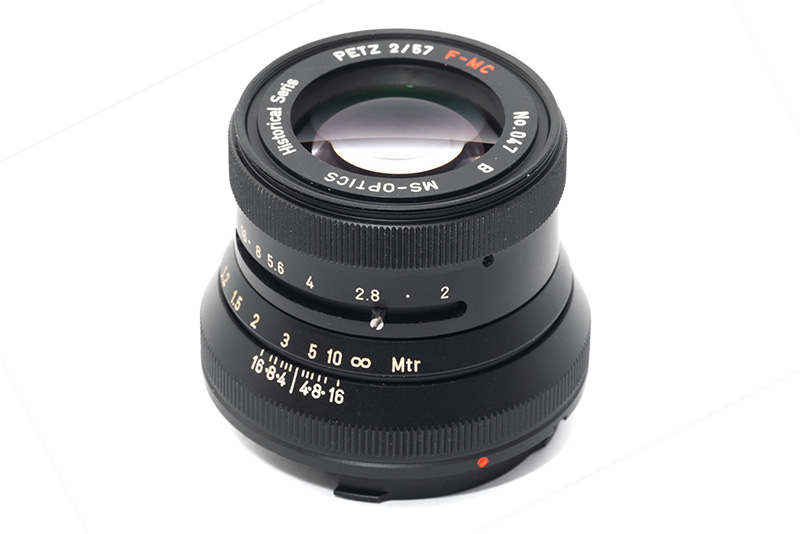
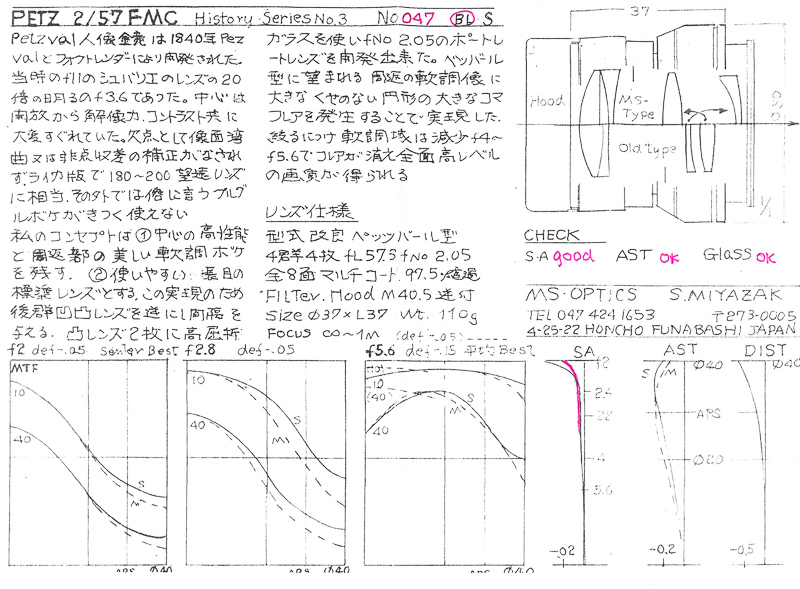
Full Review: MS-Optics 57mm 2.0 Petz
- 57.3mm f/2.05
- Diameter: 50mm
- Length: 37mm
- Weight: 114g
- Filter Diameter: 40.5mm (reversed)
- Number of Aperture Blades: 14 (rounded)
- Elements/Groups: 4/4
- Close Focusing Distance: 1.0m
- First released: June 2018
Also available as “Vario” version where the level of correction of the spherical aberration can be adjusted.
Personal opinion:
This lens is recommended by MS-Optics as “easy to use” and I can second that. It already shows good contrast and resolution at its maximum aperture and it is also more affordable than some of the faster options.
Sonnetar 73mm 1.5
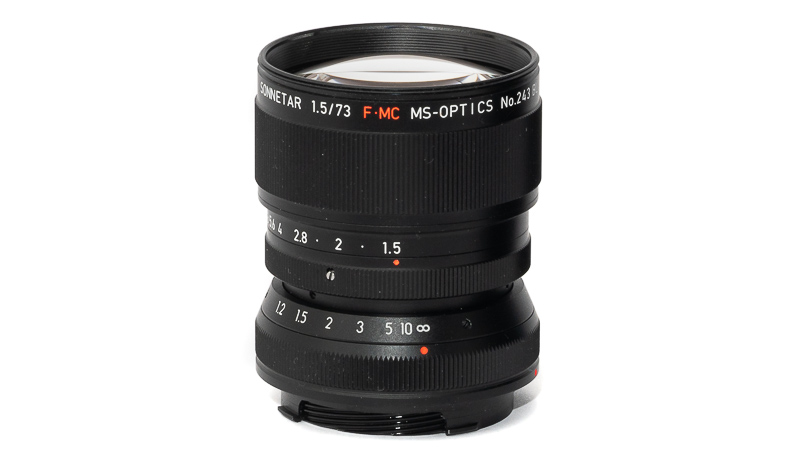

Full Review: MS-Optics Sonnetar 73mm 1.5
- Diameter: 50mm
- Length: 56.4mm
- Weight: 201g
- Filter Diameter: 49mm (reversed)
- Number of Aperture Blades: 16 (rounded)
- Elements/Groups: 5/4
- Close Focusing Distance: 0.9m (measured)
- First released: March 2018
Personal opinion:
This 73mm 1.5 is very small and lightweight, yet surprisingly sharp at f/1.5 where it matters and good enough for landscape shooting stopped down.
Bokeh is generally nice too, but a bit unsightly at f/1.5 with defocused light points in the background and unfortunately the amount of longitudinal CA is really high.
Aporis 135mm 2.4

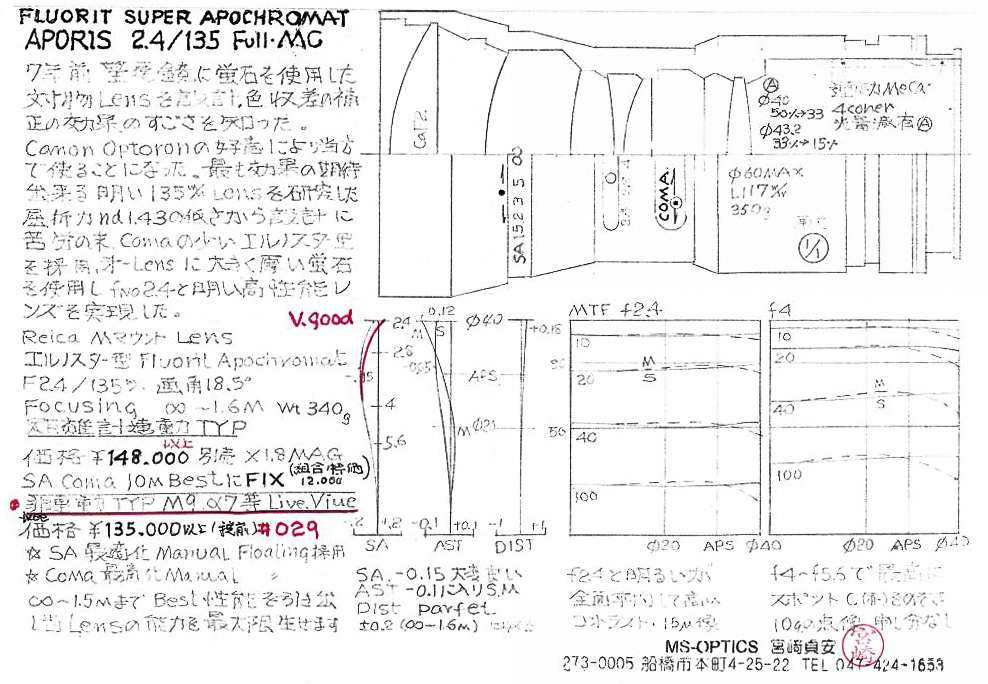
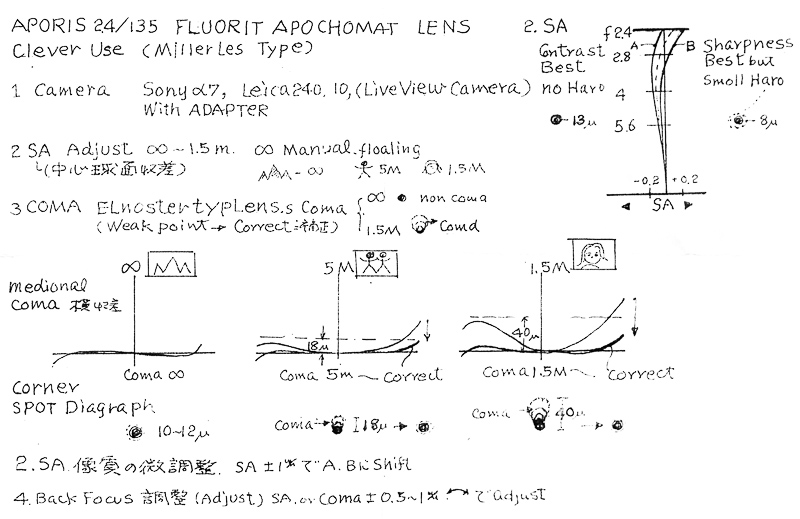
Full Review: MS-Optics Aporis 135mm 2.4
-
- Diameter: 60mm
- Length: 120mm
- Weight: 360g
- Filter Diameter: 58mm
- Number of Aperture Blades: 16 (rounded)
- Elements/Groups: 5/5
- Close Focusing Distance: 1.3m* (measured)
- First released: May 2017
*depending on the settings of Coma and SA adjustment rings these values are subject to change
There are two different M-mount versions of the 135mm 2.4: one with rangefinder coupling (which allegedly leads to increased vignetting) and fixed SA and Coma rings, and the one you see in the picture.
Personal opinion:
From a technical point of view this is probably the best performing MS-Optics lens – also thanks to using one of Canon’s famous CaF2 elements. A truly unique lens I highly value but not a good choice when solely relying on the rangefinder to focus. Also a bit of knowledge about optics is helpful to make good use of the SA and Coma adjustment rings.
Trivia
- Many lenses are available in a wide variety of colors to match different rangefinder cameras
- The 24mm 2.0 is also available with different paintings on the front barrel and lens cap, e.g. of Mt. Fuji or Tutankhamun
- The most complex lens is the 50mm 1.0 ISM featuring 7 elements, the simplest is the Hipolion 19mm 8.0, which consists of only 2
- Most lenses feature a small groove for adding a 6-bit code, but the groove is too big, so additional light will hit the 6-bit code reader of digital Leica cameras and confuse them – a small piece of duct tape can be used to solve this issue
- Most of the aperture diaphragms used in these lenses are made by Otto Niemann Feinmechanik in Germany
- A few of these lenses feature spelling errors on the casing (e.g. Apora instead of Aporia, Seris instead of Series and Tpirlet instead of Triplet) and there are many more in the data sheets
- Miyazaki used to convert various lenses to M-mount, the most reknown are probably his conversions of Contax-G lenses, but there are plenty more you may (or may not) come across.
I also reviewed one of those lenses, a converted Minolta 40mm 1.7 Rokkor-QF - If you live in Europe and need one of these lenses serviced you can get in contact with Skyllaney Opto-Mechanics in the UK
Further reading
- All Reviews of M-mount lenses
- Lens aberrations explained
- Analogue Adventures Landing Page
- Manual Photographers Series
Support Us
Did you find this article useful or just liked reading it? Treat us to a coffee!
![]()
![]()
![]() via Paypal
via Paypal
This site contains affiliate links. If you make a purchase using any of the links marked as affiliate links, I may receive a small commission at no additional cost to you. This helps support the creation of future content.
Latest posts by BastianK (see all)
- Full Resolution Pictures getting fixed - July 4, 2025
- Analogue Adventures Part 42: A wedding with Eastman Double-X 200 - July 2, 2025
- Vivo X200 Ultra – The Death of the compact Camera - June 29, 2025
Nice article! I added Apoqualia 28/2 III (Urushi Mountain version) to my MS-Optics collection about 1 week ago and I’ve been enjoying shooting with it recently. Version III is actually very light, just 50g according to the data sheet. Mine measures in at 48g with the hood (without caps) and 46g without the hood. I guess the 70g weight found in the booklet and some other sources is for the version II. The difficult part of using this lens with the hood on is that I need to change the aperture with a toothpick and it’s a bit hard to see where it’s at as the aperture marking dot is somewhat obscured by the hood as well. Other than that I like it a lot.
Juha, I bought mine secondhand and the hood was missing, so I got a Heliopan 28mm UV filter and use that as a short hood instead. If you screw in the filter tightly enough you can adjust aperture by twisting the filter, no need to use a toothpick or fingernail. Mine is a version I lens and hoods are no longer available from MS-Optics, I asked.
Thanks Brad!
I’ve read that the filter method could be used for adjusting the aperture on version II of the lens (and I guess on version I too) but no longer on version III. One Japanese seller had written a comment like that to justify why version II (that he was selling) would be preferable over III. Not sure if that is fully accurate or not. I don’t usually use filters though and I prefer to use the tiny hood for a bit of protection so I think I will just keep working with toothpicks for now. I quite like this lens on my A7C though the extreme corners and furthermost edges are never sharp even at f8. In the way I shoot street / city scenery (usually in portrait orientation), those areas are usually not critical. I like the rendering a lot at wide open for close-ups and then again at f8 for long distance city shots where majority of the frame is sharp (need to focus in midframe though to tackle some field curvature)…
In Tokyo version III can still be bought as new in some places but earlier versions are just available used / 2nd hand occasionally and usually at elevated prices.
Ah, I didn’t realize you couldn’t add a filter to version III.
This lens can produce beautiful and artistic results with a close-focus helicoid; it already focuses quite close but the adapter pushes it into another level with nice bokeh.
I agree about the close-up results. I use mine with CV VM-E close focus adapter II and it’s pretty sweet at the very close range while keeping a nice level of central sharpness wide open.
Thanks for this overview, it’s nice to have all this information in one place.
I have the 28mm/f2 Apoqualia and the 73mm/f1.5 Sonnetar, using them on Sony A7iii. The 28/2 is a mess on Sony full-frame except at close range (strong vignetting and corner smearing) but on an APS-C camera (or in APS-C mode on a high-resolution full-frame camera) it’s quite nice. I had a NEX-6 that was a good match for the 28/2 and made for a very small, nearly pocketable package.
Thank you for putting all the info together. This is the most comprehensive overview I have read for MS lenses. I personally have a 28/2 and find it to be a very interesting and quirky lens. I’m considering getting a VarioPrasma 50mm 1.5 and I’m curious if you have some thoughts on it. (also pretty interesting that Plasmat was misspelled as Prasma).
P.S. MS also once made a 25/1.1 lens for Pentax Q http://fotoborse.blog.jp/archives/1736428.html.
Didn’t get a chance to use the Varioprasma yet, but it could be another lens where the rendering can be adjusted to taste which I liked about the 135mm.
I think the Prasma name is affected by Japanese language, as the original (Paul Rudolph) Plasmat Lens is written as プラズマレンズ in Japanese katakana which is used for loanwords. This is basically read as purazumarenzu which pretty much sounds like prasma lens phonetically. As there is no L in Japanese vocabulary, they use R in place of L too and those 2 letters get mixed in Japanese all the time when loanwords are translated back to English.
I’ve never tried this lens myself, but I have some interest in it too. It seems to get really wild in terms of rendering. This is a Japanese review article on it which I found interesting: https://maenomeri.tokyo/ms-vario-prasma/
I think it’s unlikely, but I hope Mr. Miyazaki makes some lenses for other camera mounts 😀
Bastian why don’t you get in the business of designing lenses like Mr. Miyazaki. Get a quick masters degree in optic science. I think you would love it
Maybe when I am retired 🙂
Apparently there’s also a t-mount version of the 135/2.4 (with SA control, but no coma control). I saw it on US eBay when I went looking for the lens recently.
Great article, Bastian. I wasn’t even aware of about three quarters of the lenses on the list.
Nice list and overview of MS-Optics lenses. But I wish you would have gone a little further. Miyazaki-san is not releasing those lenses for the money alone. He is a big lens design fan and is experimenting with lens formulas and modern materials and knowhow. Behind most of the releases hides an idea to push an existing lens design further or rerelease an almost forgotten design again to the light of modern digital photography. So I wished that you would have added the idea or lens design of every release too.
If you don’t mind I can give a short list
* Perar 17mm 4.5 = retro focus super wide ultra-thin design
* Hipolion 19mm 8.0 = Goerz Hypergon from 1900
* Perar 21mm 4.5 = super wide ultra thin Triplet
* Aporia 24mm 2.0 = ultra thin Gauss
* Perar 24mm 4.0 = ultra thin Triplet
* Apoqualia 28mm 2.0 = ultra thin retro focus Planar Gauss
* Perar 28mm 4.0 = ultra thin Triplet
* Apoqualia 35mm 1.3 II Slim = tiny (collapsible) ultra bright Gauss
* Apoqualia 35mm 1.4 = tiny very bright Gauss
* Perar 35mm 3.5 = tiny Triplet
* Historio Prot 40mm 6.3 = Zeiss Protar from 1890
* Historio Dagonar 40mm 6.3 = Goerz Dagor from 1905
* ISM 50mm 1.0 = small ultra bright high performance Gauss
* Sonnetar 50mm 1.1 = small ultra bright Sonnar
* MS-Mode 50mm 1.3 = small ultra bright Sonnar based on Nikon S Carl Zeiss Sonnar 50mm 1.5
* Sonnetar 50mm 1.3 Slim = small ultra bright Sonnar based on Carl Zeiss Jena Sonnar 5cm 1.5 from 1932
* Varioprasma 50mm 1.5 = Meye Görlitzr Kino-Plasmat from 1930 (for movies)
* MS-Mode 50mm 3.5 Apoqualia = Voigtländer Heliar
* Xenomax 50mm 3.5 = small high performance Xenotar
* Elnomaxim 55mm 1.2 = ultra bright compact Ernostar
* Petz 57mm 2.0 = (variable) compact Petzval
* Sonnetar 73mm 1.5 = ultra bright compact tele Sonnar
* Aporis 135mm 2.4 = high performance fluorite apochromat (Canon Optron)
That was the information I could gather from the descriptions online.
Furthermore the MS-Mode 50mm 1.3 and MS-Mode 50mm 3.5 Apoqualia seem to not have a Leica M but a Leica Thread mount (L39). The MS-Mode 50mm 1.3 was available in different versions where you get a Nikon S version with a Nikon S to L39 adapter. The shown image is from a Leica thread mount version.
http://camera-wiki.org/wiki/MS_Optical_R%26D
https://camerapedia.fandom.com/wiki/MS_Optical_R%26D
For the missing information about the Varioprasma 50mm 1.5:
Filter Diameter: 40
Number of Aperture Blades: 16 rounded
https://www.japancamerahunter.com/2019/05/camera-geekery-ms-optics-vario-plasma-1-5-50-m-mount/
I don’t think 40mm is the correct filter size of the 50mm 1.5 as 40mm is not a usual filter size at all.
Several times in the past JCH published wrong specifications (or copied them from the data sheets without veryfing them), so I don’t consider them a trustful source.
I also don’t think adding “tiny Triplet/Gauss/Sonnar” is really helpful information.
Additionally, I think the information you want about each design would come from translating the description Miyazaki gives. Although your information may already be based on that.
I am in the process of getting sufficiently high quality scans of the lens texts to OCR them and will report back at some point.
That is the point. Miayazaki-san gives a lot of inside into the idea behind every lens release in his Japanese notes. Unfortunately only few people outside Japan can read and understand written Japanese. Me too. Not for all lenses those notes are available online and only a part is translated. Even if lens names are in Romaji then the text can be misleading. For example there is no translated text for the Elnomaxim. The text mentions the Ernostar only briefly and goes in depths about Bertele developing the Sonnar in 1932. A lot of people think the Elnomaxim is a Sonnar design but it is an improved Ernostar (Elnomaxim = Ernomaxim).
So long story short, it would be helpful for English readers to have this information from the notes. Even better would be full translations of the notes.
One thing that isn’t clear to me: I previously read that Miyazaki designs and makes the lenses himself in his basement, but Bastian’s article refers to him specifically as the CEO and lens designer. Are the actual lenses manufactured by employees/contractors?
Miyazaki Optical is an one-man business established in 2015. Mr. Miyazaki is the CEO and also the only worker of this company. Each lens parts is provided by other optical companies and assembled by Miyazaki himself.
I’d like to add that there are three versions of MS Optics 28/2, with different engraving on the front lens ring: APOQUALIA-G, APOQUALIA-II and APOQUALIA-III. I believe the optical design of the three are the same, but they have different housing and different minimum focus distances. The minimum focus distances marked on lens are 0.8m, 0.4m and 0.6m.
I’m not sure if the version II and III have different weight than the first version. My first version 28/2 weights 51g with hood and 49g without
The (Aegean) Sea and Sun (Mountain) Urushi editions of Apoqualia III (seen here https://www.japancamerahunter.com/2020/04/camera-geekery-ms-optics-apoqualia-g-28mm-f2-m-mount-urushii-special-edition/) are also a bit different in the way that they have Apoqualia engraving on the front lens ring without the number or G but they are based on version III, and they have minimum focus distance marking on the lens up to 0.5m. They focus to 0.55m though (around the mid-point between 0.6m and 0.5m markings). I just bought the Sun (Mountain) version a couple of weeks ago. This version’s weight is 50g according to the data sheet and I measured mine at 48g with the hood (without caps).
Thanks Bastian for this outstanding summary and overview. It underlines that your blog is special and opens the horizon for photographers that are not aiming for the highest and most expensive technology but for new image-expressions or very small lenses or something that the big producers do not and can not deliver. I often experienced that such a lens provides more fun and sometimes even more appealing pictures than a “perfect” lens.
Thank you very much for these kind words!
Thank you very very much for compiling all this information here!
Hello Bastian,
I guess that you and me are the only ones in Germany who are in love with the lenses from MS-Optics 😉
I can not thank you enough for testing this lenses and share your experiences with us. Owning much lenses and having tested some of them, I know how much work this is.
Just yesterday I got my MS-Optics Xenomax 3,5/50mm delivered. This ist an awesome good lens. It is sharp and contrasty all over, it is virtually free from CAs and fringing and it has no field curvature. Despite beeing one of the optical most perfect lenses from Mr. Miyazaki, it still is a quirky lens. Therefore I love this lens, too. Sounds crazy, but as Dan said:
This lens provides more fun and sometimes even more appealing pictures than a “perfect” lens.
Best regards,
Christian
I am very glad to see there is a person who is interested in Miyazaki lenses overseas.
I am Japanese and living in Tokyo.
I have used almost all Miyazaki lenses for years, and came to know that slow Miyazaki lenses like F3.5-4.5 are more attractive than fast ones like F1.0-F1.4
My favorite lenses are Perar 4.5/17, 4.5/21, 4/24 ,4/28 and 3.5/35 when they are used on APS-C Cameras like Leica CL.
Except Perar, I love Xenomax 3.5/50 that is extra sharp even on fullframe cameras like Leica M11.
Aporis 135mm 2.4 is also amazing but a little bit too long with its hood.
Mr.Miyazaki is high aged but still powerfully continuing to develop new lenses with his grandson. I sometimes call him to deliver lens impression and sometimes ask him to overhole my Miyazaki lenses.
Thank you for your nice article !!
From Tokyo, Japan
Nice to see you find your way here!
Unfortunately it is significantly more difficult/costly to acquire these lenses overseas.
I am wondering about performance of wide angle Perars on M11. Any experience, using your “favorites” above on M11, instead of APSC cameras?
On M11 there is very little color cast compared to M9/M10/M10r but depending on the lens higher vignetting and worse corner sharpness than on M10.
Hey Nagao,
I’m an insanely huge fan of Ms-Optic lenses and the legend Miyazaki himself. But, I’ve got no clue where to get those lenses (no eBay pls, too expensive). Any suggestions?
Here: https://www.mkdirect51.com/
I recently bought a Fuji X-Pro from Japan which happened to include a Perar 24mm f4. I had no knowledge of Mr. Miyazaki’s work beforehand, but the purchase pulled me into a rabbit hole of these fascinating lenses. Thanks for the article and all the information.
Interesting set you bought there 🙂
Note that the Apoqualia 28mm 1.7 has a 32mm filter thread, not 34mm. Nobody makes 32mm screw-in filters, but I have been able to find 32mm step-up rings to allow me to use larger filters.
I added that piece of information.